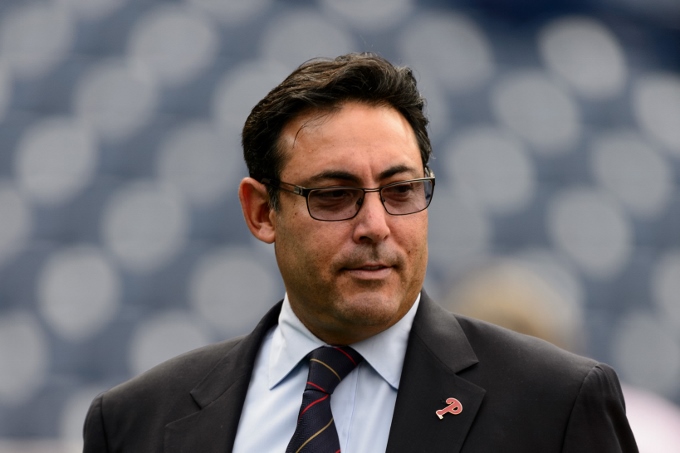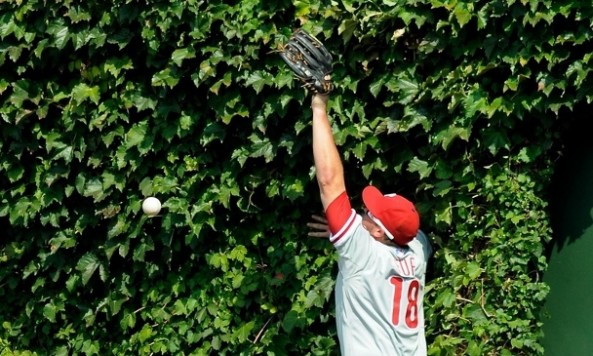
It's probably going to be a rough year in Philadelphia. But what do you expect from a club that has five offensive starters aged 34 or older and three members of their rotation aged 30 or older? It's an old team in a young division – and those old players aren't what they used to be.
Of course, simply saying "age" as a weakness for the Phillies is a bit of a cop-out. Age is a weakness, the injury-prone nature of the club is a weakness, their middling minor league system is a weakness…really, the organization is in an awful place right now. But in my mind, the two biggest weaknesses of the Philadelphia Phillies in 2014 are their management and their lack of depth.
Let's talk about the management, which has been a constant topic of discussion since Ruben Amaro took over as GM following the club's 2008 World Series win. You can point to the team's success in the first three years following Amaro's promotion, but the Phillies have gone backwards in the playoffs in each year – from World Champions to National League champions to NLCS losers to NLDS losers. Over the last two years, the situation has gotten even more bleak in Philadelphia – the team finished at .500 in 2012, and lost 89 games in 2013.
Of course, it's been under Amaro that the Phillies have had their five-highest (six, counting 2014) payrolls in club history. By the time the 2016 season is in the books, the Phillies will have spent over $1 billion on player salaries over the past seven years – and all they have to show for it since that 2008 World Championship is a 2009 pennant and a depleted farm system. Amaro started gutting his farm system in 2009, trading for guys like Cliff Lee, Roy Halladay, Roy Oswalt, and Hunter Pence. Some of those deals (Lee, Halladay) worked out spectacularly. Some (Oswalt, Pence) weren't as beneficial in the long-term.

And that brings me to my next point about Amaro – he's not too great at selling off his veterans. On the same day that the Phillies acquired Halladay from the Blue Jays, they traded Lee to the Mariners for a trio of mediocre prospects. Dealing Lee necessitated the Oswalt trade that summer, which cost the Phillies three prospects, including current Astros starting shortstop Jonathan Villar. After the 2010 season, Amaro rectified his mistake by signing Lee as a free agent, which cost the Phillies their first-round pick as compensation (though they received two picks for letting Jayson Werth walk).
2011 was the real disaster for Amaro at the helm though, as he traded four prospects to the Astros in exchange for Pence. Three of those four prospects ended up as top ten guys in Houston's organization. As the Phillies began to struggle in 2012, Amaro didn't do a good job recouping his losses on his veterans. He traded Pence to the Giants for three players, only one of which (Tommy Joseph) is still in the organization. Shane Victorino was sent to the Dodgers for three players, only one of which (Ethan Martin) is still in the organization. All the Phillies have to show for two trade chips a year and a half later is a catcher who has been suffering from post-concussion syndrome and a starting pitcher that's probably going to end up in the bullpen.
Last year, Amaro did nothing to cash in on the declining value of his veterans. Oh wait, let me rephrase that – he traded Michael Young for a guy that would never pitch in the organization and was traded in December as part of the Brad Lincoln trade. And really, that's why Amaro is such a problem for the Phillies right now. It's not as if the Phillies were in the hunt in July, either. They were 48-48 at the All-Star Break, 6.5 games behind the Braves in the NL East. They then proceeded to lose 13 of their next 15 games and were ten games back by July 27th. Yet, Amaro…did nothing.

The Phillies had a decent opportunity to at least try to rebuild their depth. Instead of trading Chase Utley, Amaro gave him a contract extension right before Utley's ten and five rights came into effect. Instead of dumping Jonathan Papelbon for whatever he could get, Amaro stubbornly held on to him, watching as Papelbon pitched to a 4.29 ERA in August and September. Instead of trading 35-year old catcher Carlos Ruiz walk or trading him at the deadline, Amaro gave him a three-year contract extension. Do you see what's going on here?
The management of the Phillies has caused their lack of depth. The team essentially went into 2013 without a right fielder, which led to Delmon Young (who started the year on the DL) earning the most playing time in right with 64 starts. When Ben Revere broke his foot heading into the All-Star Break, John Mayberry Jr. got a bulk of the playing time in center – but Mayberry was splitting time with Young in right and was largely terrible, so Jayson Nix started getting more playing time. Then Domonic Brown got banged up, and Darin Ruf, who had been playing first, had to play left while Kevin Frandsen started at first. Then Cody Asche was called up because Michael Young stunk, but Young was kept in the lineup and shifted over to first while Ruf played right. Then, Young was traded, and Frandsen still got more playing time at first in September than Ruf, despite Cesar Hernandez being given a chance to play center because Mayberry and waiver claim Roger Bernadina were getting playing time in right.
I mean…can you even comprehend all of this? They went into 2013 without a solid plan at one position, and the house of cards began to crumble on Opening Day. Mayberry started 84 games at all three outfield positions, and hit .227/.286/.391. 14 different players started games in the outfield, and only six of them are still in the organization today. What was the point of wasting a total of 224 outfield starts on players who finished the season with a negative fWAR? Why was the equivalent of a full season of playing time given in the infield to Michael Young and Kevin Frandsen?
There is some good news coming out of all of this for the Phillies and their fans, though – another disastrous season in 2014 will likely spell the end of Amaro's tenure in the city and will bring in some new blood in the front office. But a lot of the damage has been done already – the Phillies already have $113 million dedicated to their 2015 payroll and $71.5 million dedicated to their 2016 payroll (which doesn't even include any of Utley's multiple vesting options). I'm not saying the club will be in the clear by then either, because Brown and Revere, two of the team's better young players, will hit the free agent market after 2017. The process to build the Phillies back into contenders will be a long, painful one, and a lot of this mess was caused by one man.

